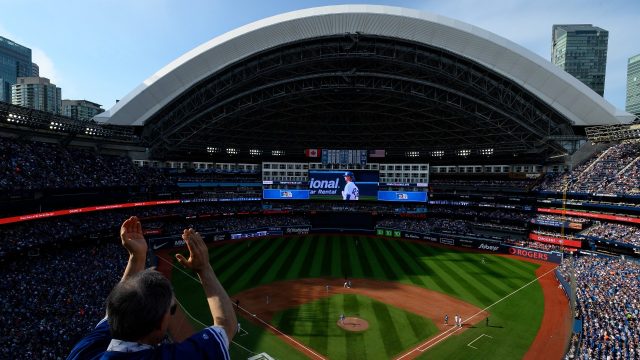Last season the Toronto Blue Jays struggled to score runs at the rate they had in recent years, and offensive firepower remains a significant concern heading into 2024.
In fact, according to a fan survey conducted by The Athletic, 70.5 per cent of 2,444 respondents described the team’s ‘offensive approach’ as its biggest weakness.
That terminology is interesting because it’s difficult for a club to have an all-encompassing offensive approach. Bo Bichette’s method for attacking at-bats won’t resemble George Springer’s, and no matter what instruction hitters receive there’s no one-size-fits-all method to handling MLB pitching.
At the same time, there is evidence that what the franchise prioritizes on offence is evolving. Not so long ago the team showed a preference for acquiring players with skill sets headlined by impressive raw power.
Teoscar Hernández is the most successful example with Derek Fisher the most obvious flop. Players like Randal Grichuk and Kendrys Morales were also lauded for the exit velocities they produced when Toronto acquired them. The opportunities Rowdy Tellez got were at least somewhat tied to his status as one of MLB’s best pure ball strikers. The Blue Jays were never solely interested in Statcast darlings, but collecting them was a part of their team-building strategy for a time.
More recently that hasn’t been the case.
Prior to the 2023 season, Toronto traded Hernández and Lourdes Gurriel Jr. — bringing back Daulton Varsho, whose exit velocity has sat below league average in each of his MLB seasons. The team’s outfield was rounded out by Kevin Kiermaier, who has shown some surprisingly strong raw power at times in his career, but not lately.
The Blue Jays also added Brandon Belt, a guy with an average exit velo that had been above average in one season since 2018 prior to signing. He’d also never hit a ball at 110 mph or harder since the beginning of the Statcast era (2015).
Belt’s excellent season with the Blue Jays goes to show that raw power isn’t everything when it comes to offensive success. That said, the team’s ability to hit the ball with authority fell off a cliff in 2023 compared to other campaigns in Toronto’s recent competitive window.
|
Season |
Average EV |
MLB Rank |
Hard-hit% |
MLB Rank |
|
2020 |
89.5 mph |
3rd |
41.8% |
4th |
|
2021 |
90.3 mph |
1st |
42.2% |
3rd |
|
2022 |
90.2 mph |
1st |
44.0% |
1st |
|
2023 |
88.7 mph |
23rd |
38.7% |
19th |
Some of that dropoff can be attributed to underperformance from guys like Springer, Alejandro Kirk and Vladimir Guerrero Jr. — but a great deal of it has to do with personnel.
During the off-season, the Blue Jays have made moves suggesting that raw power will not be a focal point of their offence in 2024 by bringing back Kiermaier, adding Isiah Kiner-Falefa (career-best 39th percentile exit velocity in 2023), and signing Justin Turner (55th percentile exit velocity in 2023).
At the same time, barring a surprise signing, the club will have parted ways with Matt Chapman — who ranked fifth among qualifying hitters in average exit velo and second in hard-hit rate last year.
The fact that Turner had a more successful offensive season than Chapman in 2024 is another data point that shows us that scorching the ball isn’t everything. Even so, a Blue Jays team that was in the bottom third of the majors in ball-striking metrics could easily drop further in 2024. Toronto has clearly pivoted to building a group of hitters whose greatest strength projects to be their ability to avoid strikeouts.
While that rebrand has its merits, it’s worth noting that creeping towards the bottom of the league in exit velocity could be dangerous. Last season the worst five exit velocity lineups had an average wRC+ of 89.8 – well below league average of 100. In 2022, that number sat at 89 even.
In the nine years since we’ve had exit velocity readings, the World Series winner has ranked below where the Blue Jays sat in 2023 just once, as the 2016 Chicago Cubs were 24th. Only one of the last seven champions were below-average by average exit velocity (17th in the majors) — and that was a 2019 Washington Nationals team that exceeded all reasonable expectations.
Although exit velocity may feel like a specific or arbitrary statistic among so many that define an MLB offence, hitting the ball hard is central to offensive success.
There are players and teams that find ways to thrive despite that not being their strength, like Danny Jansen — who produces excellent power numbers with an approach that emphasizes pulling the ball in the air to the shallowest part of the ballpark. As a general rule, though, power is most easily derived from hitting the ball with authority, and power production is arguably the best driver of run scoring.
It seems like the 2024 Blue Jays will not barrel the ball up with the consistency of previous iterations of the team. They may compensate with more plate discipline and contact ability, but an inability to punish the baseball may well lead to another season of underwhelming offence.




No comments:
Post a Comment